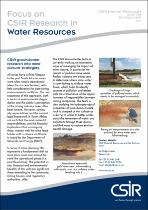 ResearchSpace
ResearchSpace
Focus on CSIR research in pollution waste: CSIR Groundwater research into mine closure strategies
JavaScript is disabled for your browser. Some features of this site may not work without it.
- ResearchSpace
- →
- Research Publications/Outputs
- →
- Conference Publications
- →
- View Item
| dc.contributor.author |
Turton, A

|
|
| dc.date.accessioned | 2007-08-15T10:20:41Z | |
| dc.date.available | 2007-08-15T10:20:41Z | |
| dc.date.issued | 2007-08 | |
| dc.identifier.citation | Turton, A. 2007. Focus on CSIR research in pollution waste: CSIR groundwater research into mine closure strategies. 2007 Stockholm World Water Week, 13-17 August 2007, pp 2 | en |
| dc.identifier.uri | http://hdl.handle.net/10204/1111 | |
| dc.description | 2007 Stockholm World Water Week | en |
| dc.description.abstract | All mines have a finite lifespan. In the past South African mines were often simply abandoned when the ore was finished, with little consideration for post-mining environmental conditions. The consequences of this approach, both in terms of environmental degradation and the public’s perception of the mining industry have often been severe. However, community expectations and the current legal framework in South Africa are such that the environmental responsibilities, and the financial implications that accompany these, remain with the mine leaseholder until a closure certificate is issued by the Department of Minerals and Energy (DME). In terms of mine planning, this represents a fundamental shift as mine plans must now extend beyond the operational phase (i.e. post-life-of-mine). The potential social, financial and environmental benefits of this shift are significant, these extending to the community, mining houses, and regulatory authorities, alike. The CSIR Groundwater team is currently working on innovative ways of managing the impact of mine closure, in particular the decant of polluted mine water. Radon isotopes are being used to determine where mine water is contributing to surface water flows, which helps to identify sources of pollution and assists with the critical issue of the apportionment of responsibility between mining companies. The team is also studying the hydrogeological properties of mine dumps (waste rock is dumped at the surface as a slurry) in order to better understand the movement of water and pollutants through these dump sand find ways to reduce environmental damage | en |
| dc.language.iso | en | en |
| dc.publisher | CSIR Natural Resource and the Environment, 2007 | en |
| dc.subject | Groundwater research | en |
| dc.subject | Mine closure strategies | en |
| dc.subject | Environmental degradation | en |
| dc.subject | Stockholm world water week, 13-17 August 2007 | en |
| dc.title | Focus on CSIR research in pollution waste: CSIR Groundwater research into mine closure strategies | en |
| dc.type | Conference Presentation | en |
| dc.identifier.apacitation | Turton, A. (2007). Focus on CSIR research in pollution waste: CSIR Groundwater research into mine closure strategies. CSIR Natural Resource and the Environment, 2007. http://hdl.handle.net/10204/1111 | en_ZA |
| dc.identifier.chicagocitation | Turton, A. "Focus on CSIR research in pollution waste: CSIR Groundwater research into mine closure strategies." (2007): http://hdl.handle.net/10204/1111 | en_ZA |
| dc.identifier.vancouvercitation | Turton A, Focus on CSIR research in pollution waste: CSIR Groundwater research into mine closure strategies; CSIR Natural Resource and the Environment, 2007; 2007. http://hdl.handle.net/10204/1111 . | en_ZA |
| dc.identifier.ris | TY - Conference Presentation AU - Turton, A AB - All mines have a finite lifespan. In the past South African mines were often simply abandoned when the ore was finished, with little consideration for post-mining environmental conditions. The consequences of this approach, both in terms of environmental degradation and the public’s perception of the mining industry have often been severe. However, community expectations and the current legal framework in South Africa are such that the environmental responsibilities, and the financial implications that accompany these, remain with the mine leaseholder until a closure certificate is issued by the Department of Minerals and Energy (DME). In terms of mine planning, this represents a fundamental shift as mine plans must now extend beyond the operational phase (i.e. post-life-of-mine). The potential social, financial and environmental benefits of this shift are significant, these extending to the community, mining houses, and regulatory authorities, alike. The CSIR Groundwater team is currently working on innovative ways of managing the impact of mine closure, in particular the decant of polluted mine water. Radon isotopes are being used to determine where mine water is contributing to surface water flows, which helps to identify sources of pollution and assists with the critical issue of the apportionment of responsibility between mining companies. The team is also studying the hydrogeological properties of mine dumps (waste rock is dumped at the surface as a slurry) in order to better understand the movement of water and pollutants through these dump sand find ways to reduce environmental damage DA - 2007-08 DB - ResearchSpace DP - CSIR KW - Groundwater research KW - Mine closure strategies KW - Environmental degradation KW - Stockholm world water week, 13-17 August 2007 LK - https://researchspace.csir.co.za PY - 2007 T1 - Focus on CSIR research in pollution waste: CSIR Groundwater research into mine closure strategies TI - Focus on CSIR research in pollution waste: CSIR Groundwater research into mine closure strategies UR - http://hdl.handle.net/10204/1111 ER - | en_ZA |





